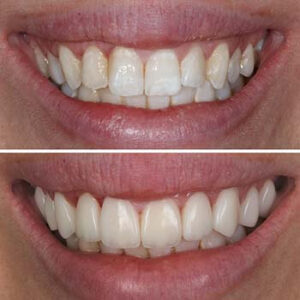Dental veneers and crowns are commonly used in cosmetic dentistry to improve the function or aesthetics of an existing tooth or teeth. Both treatments are suitable options for dental restoration although they serve different purposes. In this article, we discuss the key differences between veneers vs crowns as well as reasons for choosing dental veneers instead of crowns. So let’s get started…
Veneers vs Crowns – What’s the difference?
Patients often ask whether veneers and dental crowns are the same. While they’re not the same they do work in similar ways. For example, both treatments are used to cover an existing tooth that is flawed or has minor damage. The main difference between dental veneers and crowns, however, is the amount of tooth that is covered. Dental veneers cover the front surface of the tooth and can sometimes wrap around, depending on the technique used, whereas a crown covers the whole of the visible tooth.
So, what are dental veneers?
Veneers are super-thin shells of porcelain that are applied to the front surface of a tooth. Typically they’re used in cosmetic dentistry and frequently applied to all of the visible teeth in the smile line.
 Due to their versatility and natural-looking appearance, they’re often used to treat minor issues which once would have been treated by dental crowns. As such, your dentist may recommend veneers if you suffer from any of the following issues:
Due to their versatility and natural-looking appearance, they’re often used to treat minor issues which once would have been treated by dental crowns. As such, your dentist may recommend veneers if you suffer from any of the following issues:
- Badly stained teeth
- Cracked teeth
- Asymmetrical teeth
- Teeth that are chipped
- Small gaps between the teeth
- Minor misalignment
Veneers give individuals the chance to transform their smile for the better without having to restructure their teeth and, if their teeth are slightly crooked, without having to wear a brace.
What are dental crowns?
A dental crown is a hollow tooth-shaped cap or cover that is placed over the upper portion of the tooth that remains above the gumline.
Dental crowns are often used to replace teeth that have suffered significant damage. For example, if your tooth has had a root canal, an overly large filling, or is badly cracked, a crown may be the best option. Crowns are also used for teeth that may have worn down around the edges as can happen with severe teeth grinding.
In cases such as these, a crown keeps the tooth intact and protects it from further damage which could result in extraction.
Veneers vs Crowns – The Procedures Explained
What’s the process behind getting dental veneers?
In most cases, a thin layer of enamel (0.5mm to 2mm) has to be removed from the teeth to accommodate the veneers. Without this, the veneers would feel bulky and unnatural. When this is the case, a typical procedure is regarded as permanent which means that damaged or worn veneers can only be replaced with new veneers and the process cannot be reversed.
The good news however is that modern versions particularly ultra-thin veneers require little or no reduction of the tooth structure and the process can in some cases be reversed.
At Beyond Infinity Dental, we use digital smile design software that enables us to show patients on-screen how their new smile will look. This helps them to convey their desired outcome more effectively.
Each veneer is custom designed and made in our on-site lab and expertly colour-matched to the surrounding teeth for a beautiful natural-looking smile.
Typically, porcelain veneers can be completed in just two dental visits, making them a speedy and convenient dental restoration.
However, we also offer composite veneers that are moulded directly on to the teeth from the same composite resin that we use for tooth fillings. It’s applied to the surface of the tooth and then shaped and hardened using a curing light to create a long-lasting tooth surface. The procedure can be completed in just one dental visit and provides similar attractive results.
So that’s all you need to know about dental veneers what about dental crowns?
Dental crowns – the procedure
If a traditional crown is deemed the right option for you, an impression will be taken of the affected tooth or teeth to fabricate the crowns in a dental lab.

Just like with some dental veneers, in order to make space for the crown, part of your existing tooth may need to be reduced. Since the crown is covering most of the visible part of the tooth, the outer layer will often need to be trimmed back to make room for around a 2mm layer of porcelain.
If the tooth is decayed, any decayed material will be removed before the crown is placed. Usually, the damaged or decayed portion of the original tooth will need to be built-up again using composite material to support the crown.
Traditionally, dental crowns involve two or three dental visits spaced several weeks apart but here at Beyond Infinity Dental we also provide same-day crowns which are completed in just one dental visit, making them a more convenient alternative.
Veneers vs Dental Crowns – Which treatment is best?
Neither treatment is better than the other. Both dental veneers and dental crowns do wonders for improving the appearance of your smile but which procedure is best for you depends on the condition of your teeth and the results you want to achieve.
That said, porcelain veneers have many advantages when compared to crowns that may persuade you to opt for veneers if your dentist has given you the choice of either treatment.
Benefits of porcelain veneers
- Veneers look more natural than crowns because of the way they are made. Typically crowns look bulkier and don’t reflect the light in the same way as a veneer.
- Since more tooth structure is left when porcelain veneers are done as compared to porcelain crowns, the original tooth is stronger with a veneer than with a crown.
- Teeth with crowns may have some movement and this, in turn, can alter the bite. If this happens, the crown will need to be adjusted. On the contrary, teeth with veneers only have minimal movement although it may be recommended to wear a nightguard to protect the veneer if you clench or grind your teeth at night.
- Another primary advantage of porcelain veneers vs crowns is that the bite on the backside of the upper teeth retains the natural tooth structure, which is kinder to the lower teeth than porcelain.
To sum up, the benefits of porcelain dental veneers ultimately depends on what you’re trying to achieve.
If you’re unhappy with certain aspects of your smile then why not come and speak with the experienced dentists at Beyond Infinity Dental. We can listen to your smile goals and discuss the best treatments to help you achieve them. Book a consultation or call us on (02) 8806 3799 today.
Note: Any surgical or invasive procedure carries risks. Before proceeding, you should seek a second opinion from an appropriately qualified health practitioner.










